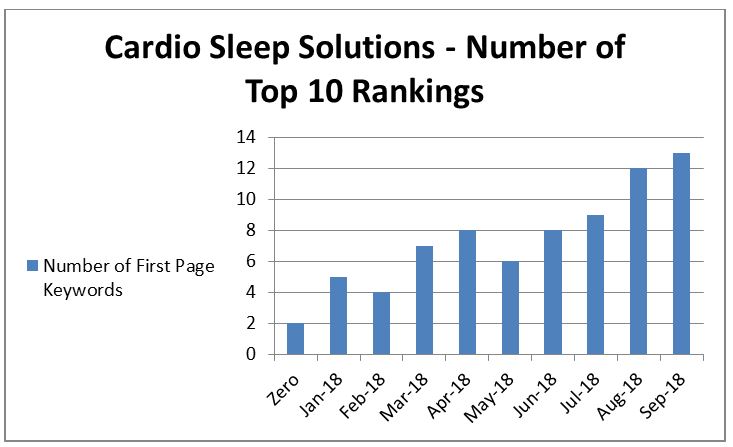How We Increased Organic Traffic to a Software company’s website by 88% in 1 year AND increased organic lead generation by 1100% in the same time frame.
Organic Traffic Progression Graph

Lead Generation Progression Table
Month
Organic Leads
Mar-24
Stage 1
- Keyword Research
- In-depth competitor research, including high resolution breakdown of competitor vs client rankings factors such as organic traffic, referring domains, domain authority, target page type, etc, content requirements, etc.
- Keyword Mapping, detailed On-page optimization for all pillar pages- Keyword focused, front-loaded meta tags at recommended character lengths.
- Detailed Technical optimization, which included clean up of disorganized blog posts (There were 2 separate sections for “blog posts” and “articles” - we merged the two and made sure the URLs reflected the site navigation hierarchy and added breadcrumbs accordingly.
- Site-wide ALT tag updates were implemented according to the keyword map
- Social media profile optimization across LinkedIn, Facebook, YouTube to include the focus keyword and more.
- Improved site and loading speed according to competitor comparisons.
Stage 2

High-scale content strategy, keyword-focused, using AI with high-level human editing, unique, AI-generated images were added per blog post, detailed on-page optimization was carried out up to the level of keyword inclusion in URL extension/slugs, meta tags, image file name+image title and image ALT, manual image re-sizing to fit SEO best practices before uploading to the image gallery and more.

At least 5 on-page blog posts per month were posted, according to prior keyword and competitor research.

At least 2 inner links were added per blog posts + additions of CTA’s throughout the blog posts were added to increase lead generation.
Stage 3

Addition of a completely new site section- a construction directory. Originally the client placed this on a subdomain, but at our recommendation added it as part of the main domain in a subfolder. The directory was added for many international regions. Best practices for international targeted and URL structure were implemented, including section-wide dynamic, SEO optimized meta tags including the focus keywords. Additional keyword research was carried out for the directory to target niche and industry specific keywords and those meta tags were implemented manually on the target pages within the directory.

Detailed on-page content was written and implemented for main international versions of the directory, including FAQs, in different languages, for each target region. A platform was created intended for use by industry professionals for them to log in and add their information in return for a link and organic traffic exposure.
Stage 4
Stage 5
Optimizing for AI.
FAQs were added on all pillar pages, implemented with FAQ schema. Organization/Logo schema was added to the homepage, About Schema, Contact Schema, Software application schema were added using the plulgin Schema Pro.
We begin an extensive Glossary project, with detailed, professional information covering every term in the construction industry at a rate of 10 pages per term per month.
We created a unique exploration report in GA4 to be able to easily track all traffic and leads from LLMs. Throughout 2025 organic traffic from LLMs steadily increased, with organic leads also coming in from ChatGPT.

A Word on the Company’s Backlink Profile
We steadily increased the company’s backlink profile, targeting the client’s focus keywords. We increased the focus keyword rank in their target region of UK, and after achieving our target, the client asked to focus only on USA rankings as a new target. Focus keywords increased by an average of 15-20 positions per keyword, which many new rankings for keywords we targeted in the Blog and in the Glossary.
The dramatic year-long surge in organic performance—an 88% jump in organic traffic and an astonishing 1100% rise in organic lead generation—unequivocally validates the client’s holistic, multi-staged SEO strategy. This success was not built on a single tactic, but on a layered approach: from establishing a solid technical and on-page foundation (Stage 1), to fueling growth with high-volume, keyword-targeted content (Stage 2), to expanding the site’s authority and search footprint with a strategic directory integration (Stage 3). The crucial link between traffic and revenue was forged through a keen understanding of user behavior and business goals, demonstrated by the conversion-focused overhaul (Stage 4) leveraging the new “free trial” model. Finally, anticipating future search trends with Schema implementation and AI/LLM optimization (Stage 5) positions the software company for sustained, high-quality `growth.
Ultimately, this case study proves that a data-driven SEO strategy, one that meticulously aligns technical compliance, content depth, conversion paths, and future-proofing, transforms a website from a passive asset into a powerful, exponential lead-generating machine.
Boost Your Business with Inter Dev’s Digital Marketing Services
Ready to see explosive growth in your online presence and lead generation, just like the tables show is possible?
Don’t let your traffic and leads stagnate. Inter Dev’s specialized B2B Digital Marketing, Search Engine Optimization, and Generative Engine Optimization services are designed to get your business found by the right customers, dramatically increase your website traffic, and convert that traffic into tangible revenue.
Take the next step
Contact Inter Dev today for a free consultation and let us develop a tailored strategy to achieve massive percentage growth for your business.
)


